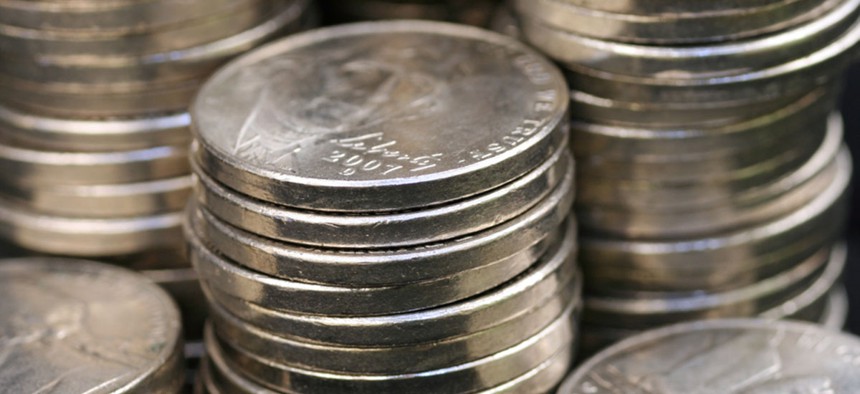
Shutterstock.com
Nickels Cost Seven Cents To Make. Scientists May Have A Solution
Since 2006, the metals used to make nickels have exceeded the value of the coin itself.
The U.S. Mint needs an upgrade.
Specifically, it’s got to find a way to make cheaper nickels. The manufacturing cost of a single five-cent coin has exceeded its value since 2006, when the price of the materials that make it up—copper and nickel—went up thanks to rising demand in the U.S. for other products relying on these materials, like wire and stainless steel. In 2017, nickels cost about seven cents each to manufacture, meaning the U.S. Mint lost $9.5 million making the coins (pdf, p.11) (not to mention the $11.5 million it spend shipping them across the country).
Back in early 2013, the Mint turned to the material scientists over at the National Institutes of Standards in Technology (NIST) in Gaithersburg, Maryland for help. It wasn’t as easy as it may seem to come up with a new nickel design; for a ubiquitous coin of little value, the nickel has a strange number of specifications, dating back to its birth 152 years ago in 1866, just after the Civil War.
The nickel as we know it today is the result of then-president Andrew Jackson’s desperation to restore faith in the American monetary system after several years of conflict and uncertainty, according to Smithsonian. People had lost confidence that the U.S. government could survive, let alone back any of the gold and silver coins in circulation then, so they started hoarding them for their value as precious metals. The government didn’t have the resources to make more coins to put into circulation to replace the hoarded gold and silver, so precious metal-based currency began to be in short supply.
In the meantime, the government had already begun printing paper currency. When the war ended, the U.S. government started making coins again, but decided that this time, it would make coins out of nickel, a commodity cheap enough that no one would hoard it. Simultaneously, they kept bills in circulation. (At the time, $0.05 was valuable enough to merit its own bill.)
This plan was going well, until one man’s impressive hubris foiled the currency system once more. Spencer Clark, the man in charge of the National Currency Bureau (which would later become the Bureau of Engraving and Printing), thought it would be funny to put his own face on the five-cent bill. The decision caused public outrage, the note stopped circulating, and president Jackson stepped in: There would only be the five-cent coin, he decided, and it would be made of a mixture of nickel and copper, two metals of equal value at the time. Little did he know that this decision would cause major headaches for scientists over a century later.
First, there’s the color. “A nickel is silver colored, but if you really look at it there’s a bit of a red tinge and that comes from the copper,” says Eric Lass, a NIST chemist specializing in metals at. Next, there’s the weight: nickels must all weigh five grams, to ensure consistency when counting large amounts of the coins at once. Nickels also have to have a specific hardness: soft enough to be engraved, but hard enough to resist easily wearing away while jangling around in a pocket.
Aside from the physical properties, nickels need to have a unique set of chemical properties. They don’t corrode when being held in a sweaty palm or dropped in a fountain, and they have a specific amount of electrical conductivity. These requirements weren’t explicitly set out by Jackson, but his choices had downstream impacts: all the vending machines and coin counters in the U.S. use conductivity to distinguish different coin types. It would cost tens of billions of dollars to reprogram or replace all this equipment, Lass says.
If all that wasn’t enough, the Mint told NIST they wanted a coin that could be made in its current facilities in Denver and Philadelphia, so the design had to be compatible with their existing equipment and techniques.
Lass and his team set out to identify a specific mix of metals that would meet all of these criteria. They thought zinc and manganese would be good candidate metals, but had no idea exactly how much of them should be mixed with nickel and copper—if you change one metal, you’re likely going to change at least one or more of the properties of the coin as a whole. Rather than making hundreds of individual sample coins with various metal ratios, the team plugged in all the metallic variables into a computer program that allowed them to model different recipes. In less than a year, they were able to come up with a metal mixture that mimics exactly everything about nickels as we currently know them and print prototypes.
Their work was published (paywall) a few years later in June of this year in the journal Integrating Materials and Manufacturing Innovation. (The Mint had asked the team to wait to publish until it could submit its biennial report to Congress.)
It’s not clear when these new nickels will go into circulation—or if they will at all (not that anyone using the coins would be able to tell). “The Mint is continuing to examine potential alternative metals for coinage,” says a Mint spokesperson. But if the Mint were able to scale up NIST’s model alloy, they’d likely save millions on printing these tiny coins every year. The organization makes billions of coins annually, including more than 1.3 billion nickels in 2017.






